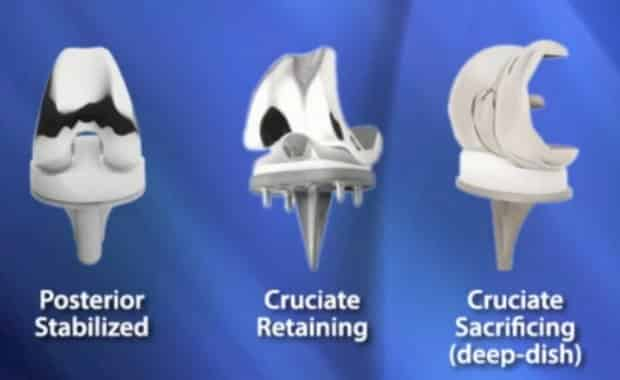
Total knee replacement implants are not one-size-fits-all or even one-style-fits-all. Prosthetic implants vary greatly by design, fixation and materials.
Your implant may be a fixed- or mobile-bearing implant; a PCL-retaining design or a PCL-substituting style. It may be fixed with bone cement or could be a cementless fixation design. The choice of implant will ultimately be made by your surgeon, based upon your physical situation, your age and lifestyle, the surgeon’s experience and the level of familiarity and trust he or she has with a specific piece of equipment and/or manufacturer.
Total Knee Implant Components: Although the overall designs of total knee implants vary, as discussed below, typical total knee replacement implants have three basic components: femoral, tibial and patellar.
- The femoral component is generally made of metal and curves around the end of the femur (your thighbone). There is a groove down the center of this part of the implant which allows the patella (kneecap) to move up and down as the knee bends and straightens.
- The tibial component is a flat metal platform with a polyethylene (plastic) insert or spacer. This component varies in structure, depending on which type of surgery is performed.
- The patellar implant is a dome-shaped piece of polyethylene that mimics the kneecap. This implant is used in some knee replacements; not in others.
Fixed Bearing Implants
The most common knee replacement implant is referred to as a fixed-bearing implant. It is referred to as “fixed” because the polyethylene cushion of the tibial component is fixed firmly to the metal platform base. The femoral component then rolls over this cushion.
The fixed-bearing prostheses provide a good range of motion and just as long lasting as other implants for most patients. In some cases, excessive activity and/or extra weight can cause a fixed-bearing prosthesis to wear down more quickly. This wear can cause loosening of the implant, causing pain and joint failure – though this is not common.
Mobile Bearing Implants
If you are younger, more active, and/or overweight, your doctor may recommend a rotating platform/mobile-bearing knee replacement. These implants are designed for potentially longer performance with less wear.
The difference between a fixed-bearing implant and a medial-pivot implant is in the bearing surface. Fixed-bearing implants and mobile-bearing implants use the same three components. In a mobile-bearing knee, however, the polyethylene insert in the tibial component can rotate short distances inside the metal tibial tray.
This rotation allows patients a few degrees of greater rotation to the medial and lateral sides of their knee.
Because of this mobility, mobile-bearing knee implants do require more support from the ligaments surrounding the knee. If the soft tissues are not strong enough, though, the knee is more likely to dislocate. Mobile-bearing implants may also cost a bit more than fixed-bearing implants.
There are no studies and no consensus that indicate that mobile-bearing implants have better durability, improvement in pain, or improvement of function than a fixed-bearing design.
Medial Pivot Implants
The Medial-Pivot knee replicates the rotating, twisting, bending, flexion, and stability of your natural knee, so it feels more like your natural knee. A normal knee actually pivots on its medial (inner side) condyle. When the knee flexes, the lateral (outer side) side rolls back while the medial side rotates in one place. This design “stays put” or is more stable during normal knee motion as opposed to sliding forward slightly.
However, compared with Fixed-Bearing designs, Mobile-Bearing knee implants are less forgiving of imbalance in soft tissues. They may cost more than Fixed-Bearing implants.
Posterior Cruciate Ligament (PCL)-Retaining or Substituting Implants
The Posterior Cruciate Ligament is one of the major ligaments in the knee. It provides support and stable movement of the knee, preventing the femur from rolling back on top of the tibia when flexed. Depending upon its condition, the type of knee implant and the surgical approach of your surgeon, this ligament can be kept or removed during total knee replacement surgery.
Posterior Cruciate Retaining: In PCL Retaining designs, rearward movement of the tibia continues to be resisted by an intact PCL, which creates stability. The femoral and tibial prostheses have notches to accommodate the ligament and the plastic insert also has a flat central surface.

Posteriorly-Stabilized Knee Implant (credit: MicroPort Orthopedics)
Posterior Cruciate Substituting: PCL Substituting knees (also called posterior stabilized knees) have raised surface on the tibial component cushion with a raised sloping cam or post which compensates for the missing PCL to give your knee stability in the absence of this ligament. This “cam and post” interaction mimics the normal function of the PCL by limiting the forward roll of the femur over the tibia and supporting backward movement of the femur as you bend or flex your knee.
Again, the choice of implant is generally made by your surgeon, based upon several factors – some of which pertain to you and your circumstances, others of which pertain to the surgeon himself (or herself) and the level of familiarity and trust with a specific piece of equipment. The patient though is well-advised to have a working understanding though of the various options in order to understand the recommendations made and the reasons behind recovery and discharge instructions.
Types of Knee Implant Fixation
The other big difference between types of knee replacements is fixation. There are cemented, cementless, and hybrid (combination of cemented and cementless) designs.
Cemented prostheses utilize a special kind of bone cement that helps hold the components of the artificial joint in place. The majority of knee replacements are generally cemented. Cemented knee replacements have been used successfully in all types of knee replacement patients. Historically, some younger, more active patients had problems with loosening cement but the material is now much improved.
Cementless implant designs become fixed by bone growth into the surface of the implant. Most implant surfaces are textured or coated with a porous material so that the new bone actually grows into the surface of the implant. Screws or pegs may also be used to stabilize the implant until bone ingrowth occurs. Recovery does generally take a bit longer as the bone grows into the prosthesis. Cementless implants are not usually a viable for patients with osteoporosis, as the existing bone must be in good shape in order to grow into the implant.
Some surgeons also use a hybrid of the two methods of fixation, though this is more common in hip replacement surgery.
Specialized and Customized Knee Implants
People with smaller skeletons sometimes present challenges that require the adoption of implants constructed for their special needs. Relatively new implants are designed to accommodate those male or female femora which are smaller from side-to-side than from front-to-back. This helps ensure the special need patient will receive the best implant fit possible.
More about Customized Knee Replacement Implants >>
The Decision
The good news is that your surgeon will make the decision regarding which implant to use, but talk with your him or her about which implant will work best for your body and lifestyle. Although the decision is ultimately your surgeon’s, you are well-advised to have a working understanding though of the various options in order to understand the recommendations made as well as the reasons for your recovery and discharge instructions.
Filed Under: Knee ReplacementKnee Implants



